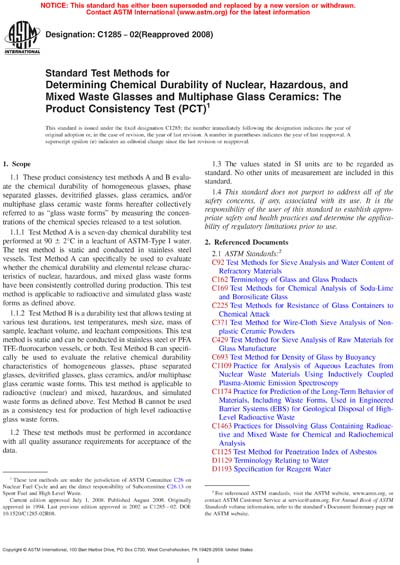Historical
ASTM C1285-02(2008)
Standard Test Methods for Determining Chemical Durability of Nuclear, Hazardous, and Mixed Waste Glasses and Multiphase Glass Ceramics: The Product Consistency Test (PCT)
1.1 These product consistency test methods A and B evaluate the chemical durability of homogeneous glasses, phase separated glasses, devitrified glasses, glass ceramics, and/or multiphase glass ceramic waste forms hereafter collectively referred to as “glass waste forms” by measuring the concentrations of the chemical species released to a test solution.
1.1.1 Test Method A is a seven-day chemical durability test performed at 90 ± 2°C in a leachant of ASTM-Type I water. The test method is static and conducted in stainless steel vessels. Test Method A can specifically be used to evaluate whether the chemical durability and elemental release characteristics of nuclear, hazardous, and mixed glass waste forms have been consistently controlled during production. This test method is applicable to radioactive and simulated glass waste forms as defined above.
1.1.2 Test Method B is a durability test that allows testing at various test durations, test temperatures, mesh size, mass of sample, leachant volume, and leachant compositions. This test method is static and can be conducted in stainless steel or PFA TFE-fluorocarbon vessels, or both. Test Method B can specifically be used to evaluate the relative chemical durability characteristics of homogeneous glasses, phase separated glasses, devitrified glasses, glass ceramics, and/or multiphase glass ceramic waste forms. This test method is applicable to radioactive (nuclear) and mixed, hazardous, and simulated waste forms as defined above. Test Method B cannot be used as a consistency test for production of high level radioactive glass waste forms.
1.2 These test methods must be performed in accordance with all quality assurance requirements for acceptance of the data.
1.3 The values stated in SI units are to be regarded as standard. No other units of measurement are included in this standard.
1.4 This standard does not purport to address all of the safety concerns, if any, associated with its use. It is the responsibility of the user of this standard to establish appropriate safety and health practices and determine the applicability of regulatory limitations prior to use.
Content Provider
ASTM International [astm]






